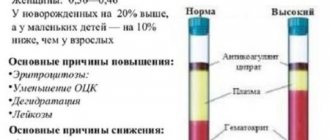A general blood test is an important component of the general clinical examination of patients in municipal and private clinics. The study of erythrocytes allows us to evaluate various indicators of these formed elements - size, shape, kinematics of aggregation, thrombus formation, etc.
ESR analysis is a study of the sedimentation rate of red blood cells over a given period of time under the influence of gravity. Today, two diagnostic tools are used that allow you to accurately analyze this indicator: the Westergren method and the Panchenkov method. Analyzes for the rate of sedimentation of erythrocytes help to establish the genesis, extent and strength of inflammatory processes in the human body. The most popular way to determine ESR in the blood is the Westergren method.
What is ESR according to Westergren?
Red blood cells are red formed elements that transport oxides throughout the body. Their main function is to remove carbon dioxide and deliver oxygen to tissues. Inflammatory, infectious, idiopathic or allergic diseases can change the size, shape, content of red cells and the rate of their sedimentation (deposition).
Sedimentation of formed elements occurs in three stages:
- Initially, individual red blood cells move downward under the influence of gravity,
- After some time, the formed elements, colliding with each other, form large clumps. The mass of particles, accordingly, increases, and they settle faster to the bottom of the test tube,
- The formation of a large number of aggregate units slows down the sedimentation process and soon stops it.
The Westergren diagnostic technique is a generally accepted method for determining the sedimentation rate of red blood cells. The main difference from the Panchenkov method is the calibration of the research results and the test tubes that are used in the analysis. It has been recommended for use since the 70s.
However, in the Russian Federation the Panchenkov method is most often used. It is worth noting that the results of both types of analyzes are identical, however, the determination of ESR using the Westergren method is more sensitive to increased rates of erythrocyte sedimentation.
Both of these diagnostic methods are relatively cheap and highly informative. The procedure also does not require any special costs or effort. Therefore, this method is usually performed without fail with other blood tests.
Attention! Methods for determining ESR in our time work in automatic mode and do not require human participation. The results are displayed in the form of a tape on which all reference values are written.
Why is Westergren's erythrocyte sedimentation rate tested?
As a rule, Westergren ESR is performed together with other blood tests. This method is included in the list of general clinical blood tests. It allows you to evaluate the effectiveness of the drug intervention or help in the early diagnosis of diseases of various etiologies.
The most common diseases that affect ESR levels in the blood:
- Sepsis,
- Abscesses of various etiologies,
- Autoimmune diseases,
- Arthritis,
- Myalgia of various origins.
It should be noted that an increase or decrease in ESR levels is not an independent disease, but a sign indicating the occurrence of pathological processes in the body. To find out the exact reason for the change in the rate of sedimentation of blood cells, additional diagnostic measures will be required. In some cases, ESR returns to normal without drug or invasive intervention.
How to normalize ESR
It will take a lot of time to normalize the erythrocyte sedimentation rate. First of all, it is necessary to determine the cause of ill health. And then begin conservative treatment of the problem.
To avoid jumps in indicators and improve well-being, doctors recommend that expectant mothers:
- drink dietary supplements with a high concentration of iron;
- stick to the right diet
- eat more fresh and stewed vegetables.
Such simple prevention methods will help normalize the indicators and protect the woman from serious consequences.
Why you need to take a blood test and what it can show will be explained in the video.
ESR norm according to Westergren
Only a qualified doctor can accurately interpret the results of ESR tests. Self-diagnosis is not recommended. The data below is provided for informational purposes, however, you can independently decipher some values and identify deviations from the norm.
The values of ESR indicators vary greatly among people of different age categories, gender and health status. In children, red blood cell sedimentation rates vary widely. The above indicator is measured in mm/hour.
Healthy ESR values for different age categories:
- In newborns, the sedimentation rate does not exceed two to three millimeters per hour. Such reduced rates are associated with a small number of peptide compounds.
- In a child under one year old – 11-18 mm/hour. High rates at this age are associated with increased tissue growth.
- In a child after one year, the indicators are two to ten mm/hour.
- Women and men show strong differences in ESR levels. In women, up to 20 mm/hour is considered normal, while in men this is already a pathologically increased value.
- In men, the norm is from 2 mm to 13-14 per hour.
Important! If Westergren's ESR is elevated during pregnancy, this is normal and does not require additional examinations. Often the ESR level in this case reaches 40 mm/hour. It is worth noting that in the 1st and 2nd semesters of pregnancy, the sedimentation rate of red blood cells can, on the contrary, greatly decrease. This condition is caused by changes in the protein composition of the blood in women.
What diseases may pathological results indicate?
Health does not always make us happy. It is during difficult periods of life that it fails. Any of us may experience any pathological processes that affect the condition of the whole organism. To find out what’s wrong and what needs to be treated, we take tests. One of the important informative indicators in this case is the erythrocyte sedimentation rate.
general information
The erythrocyte sedimentation rate (ESR) is part of the mandatory tests in a clinical blood test. It indicates how cells settle over a certain period of time.
In the literal sense of the word, they evaluate how the mixture of blood and anticoagulant separates into red blood cells and plasma. Using these data, the doctor can judge the presence of an inflammatory process, cancer, infectious or rheumatological disease.
There are three methods for determining the erythrocyte sedimentation rate: ESR according to Westergren, Wintrobe and Panchenkov methods.
Historical background: when did they start researching this indicator?
Medical specialists have long identified the relationship between erythrocyte sedimentation rate and pathologies in the body.
But it was only at the beginning of the twentieth century that ESR began to be recorded for the purpose of diagnosing diseases. This happened after one Swedish physician, R. Fareus, made a discovery: the erythrocyte sedimentation rate can change significantly during illness and pregnancy. This happened in the 20s of the last century.
There is also evidence that ESR began to be studied back in 1897, after the first experiment of E. Bernatsky. Then a different name was in use - ROE (erythrocyte sedimentation reaction).
After 1925, medical scientists began to develop methods for determining ESR. They are still used in medical practice.
What are the methods for determining ESR?
Historically, there have been several methods for determining ESR. It is important to note that each of them is significantly different from the other, therefore the norms are different. You cannot combine them, otherwise there will be confusion with the results.
The Westergren method is the most popular for determining ESR. It is recognized by leading laboratories and blood testing committees and is therefore considered the main test for testing. The time to obtain the result is 60 minutes. It will be described in more detail below.
The Wintrobe method is different in that the blood taken for testing is pure and is not diluted. The length of the tube for analysis is 100 mm. This is precisely the drawback of the method, since distorted results appear when the ESR is more than 60 mm per hour.
The Panchenkov method is that the blood is diluted with a reagent using a certain technology. The solution is drawn into a 100 mm long test tube, and after an hour the results are noted.
Westergren method for determining ESR
The international committee involved in the standardization of hematological research considers the Westergren technique to be the most accurate. To carry out the analysis, venous blood is taken from the patient, which is filled with a special cylindrical tube with an anticoagulant - sodium citrate - to the 200 mm mark. This container is placed on a tripod and left for 60 minutes.
The anticoagulant prevents the blood from clotting, while red blood cells, which have a density higher than that of plasma, settle to the bottom. How quickly the red blood cells descend depends on their ability to stick together in a particular patient. This process is called aggregation. Erythrocyte aggregates will settle faster.
This is precisely what the Westergren method of studying ESR is based on. The surface properties of red blood cells in human blood and the protein content in his plasma are taken into account. If the number of acute-phase compounds increases, which is characteristic of the inflammatory process, the aggregation capabilities of red blood cells also increase.
The result is recorded by assessing the number of red blood cells deposited in the column.
How is this method different from others?
In addition to Westergren's ESR, the Panchenkov technique is widely used in our country. To do this, a reagent (five percent sodium citrate) diluted with whole blood is placed in a special capillary. After sixty minutes, the height of the settled plasma is measured.
The ESR indicators according to the Westergren and Panchenkov method are the same with normal values. But with the acceleration of erythrocyte sedimentation, the data using the first method are reflected in higher numbers.
There is also the Wintrobe method. It is considered less accurate than the first two, so it is rarely used. In modernized laboratories, automatic analyzers are often used, which also provide ESR results.
What diseases can pathological Westergren ESR results indicate?
Indicators of erythrocyte sedimentation rate may deviate from the norm in one direction or another. When is Westergren's ESR elevated? As already mentioned, this occurs in infectious, inflammatory, rheumatic and oncological diseases.
Most often, diseases of the heart and blood vessels, pathological processes in the blood and kidneys are suspected. A high ESR result (up to 60 mm/hour) is also observed with a significant increase in the amount of acute phase proteins, such as C-reactive protein, seromucoid, fibrinogen, ceruloplasmin.
This may indicate a malignant neoplasm.
ESR can also increase (we also consider the Westergren method in this case) during pregnancy and the use of certain medications. Autoimmune processes and acute septic conditions also lead to accelerated erythrocyte sedimentation. Red blood cells descend faster in active chronic liver diseases, collagenosis and myocardial infarction.
A reduced ESR result according to Westergren is observed with an increase in protein fractions, erythremia, a significant increase in the number of leukocytes, changes in the erythrocyte structure, and sluggish hepatitis.
ESR standards for adults
People of different ages and genders have different erythrocyte sedimentation rate rates. So, for men under fifty years of age, ESR values of 0-15 mm per hour are considered good.
Results of 0-20 mm per hour are typical for representatives of the stronger sex after the specified age. In each of these cases we are talking about ESR according to Westergren. The blood of women under fifty years of age normally gives an erythrocyte sedimentation rate of 0-20 millimeters per hour.
Representatives of the fair half of humanity who have reached fifty years of age should have an ESR of up to 30 mm/h.
Soe on Westergren. normal for children
For children, there are standards that differ from those for adults. The question of what Westergren's ESR means and what its norms are in children often worries parents. Children of different ages normally have the following indicators:
- for newborns, an erythrocyte sedimentation rate of 2-4 mm per hour is considered characteristic;
- for babies from two months to a year, the ESR norm is 3-10 millimeters per hour;
- children from one year to five years – 4-12 mm per hour;
- if the child is from six to 14 years old, an ESR of 4-12 mm per hour will be normal for him;
- girls 14 years of age and older have normal erythrocyte sedimentation rates of 2-15 millimeters per hour; for boys at this age, the norm is 1-10 mm per hour.
How does ESR according to Panchenkov differ from the method according to Westergren?
There are significant differences between these methods. The Westergren method uses venous blood, and the Panchenkov method uses capillary blood. When collecting capillary blood, it is first placed on a special glass, where an anticoagulant (a substance that prevents blood clotting) is applied. After the sample has lost its coagulation properties, it is placed in a vertical direction. After about an hour, the specialist measures the plasma level.
The Westergren method is very sensitive to any changes and has a large division scale. As mentioned above, in this case, venous blood is used, which is mixed directly in a test tube with an anticoagulant. Using exactly the same method, a column of transparent plasma is measured and ESR indicators are measured. The Westergren method has a scale of two hundred divisions.
Why do ESR levels in the blood increase?
When the composition of the bloodstream changes, red blood cells begin to settle on the vessels at different rates. An increase in plasma peptide compounds - fibrinogen or paraprotein - has a strong effect. Chronic diseases accelerate the rate at which red cells settle on the walls.
In children, ESR levels increase due to the eruption of new teeth, when infected with parasites, or during physiological stress. A strong increase in sedimentation rate in adults may indicate the presence of serious pathologies in various organs:
- Inflammatory, infectious, idiopathic or allergic processes,
- Diabetes type 1 and 2,
- Deficiency of B vitamins or iron,
- Disturbances in the renal system,
- Autoimmune diseases,
- Malignant or benign neoplasms,
- Endocrine disorders,
- Burns of varying degrees,
- Hepatitis A.
Taking glucocorticoids, severe injuries or psycho-emotional stress can also increase ESR levels. If deviations in this indicator are detected, repeated diagnostic measures are prescribed to exclude a false positive result. If the result is confirmed, diagnostic measures are continued until the true cause of the disease is identified.
The luteal phase of the menstrual cycle greatly influences the rate of erythrocyte sedimentation. The changes in this case are temporary and do not require treatment. Pregnancy, as mentioned above, also has a significant impact on these indicators.
Why does ESR increase during pregnancy?
A general clinical blood test is carried out in pregnant women several times: at the beginning of pregnancy, in the middle and at 7-8 months. In this condition, normal values are slightly increased, as discussed above.
During pregnancy, many factors influence ESR. The first is a change in the peptide composition of the blood. The second is high cholesterol or iron deficiency anemia. In some cases, an unhealthy diet that does not contain enough meat products can greatly increase the erythrocyte sedimentation rate.
Psycho-emotional stress has a greater impact on women during pregnancy than in normal conditions. Therefore, it is recommended to avoid excessive emotional and physical overload.
Advice! Sharp changes in this indicator are also normal and depend on the individual characteristics of a particular organism. In these cases, you should consult a doctor only if adverse symptoms occur.
How to prepare
In order for a general blood test with determination of ESR to give an accurate result, you need to properly prepare for its delivery, observing the following rules and recommendations:
- Eliminate physical activity for the day.
- Go for analysis in a state of emotional and physical peace.
- For a week, stop taking any medications, incl. and vitamins.
- Immediately before donating the biomaterial, you should not smoke or drink coffee.
The test is taken only on an empty stomach in the morning. The less time passes between awakening and the collection of biological material, the more accurate the result will be. If a person must take any medications for medical reasons, and it is not possible to even temporarily stop taking them, the laboratory assistant must be informed about this.
Important information: Table of norms for segmented and band neutrophils in children by age
How the research is carried out
To determine ESR according to Westergren, blood is taken from the cubital vein, or in children - from a finger. A special anticoagulant is poured into the test tube, then the blood taken during the study is added.
The contents are mixed by shaking, after which the test tube is left for 1 hour.
After this time, the laboratory assistant begins to make calculations, determining at what speed the blood cells settle. The results obtained are compared with the norm and entered into a special form.
Why do ESR levels in the blood decrease?
A decrease in erythrocyte sedimentation rate may be associated with changes in body weight, use of hormonal steroids, anemia, or prolonged fasting. Overhydration is one of the leading causes of increased ESR. Often this happens either due to excess water consumption, or due to a disruption in the excretory or cardiovascular system.
Other factors that reduce ESR:
- Increased concentration of bile acids,
- Decrease in blood pH level,
- Long-term use of acetylsalicylic acid, mercury or calcium,
- An increase in the number of peptide compounds (mainly albumin) and blood cells,
- Sickle cell anemia.
In some cases, when the rate of red cell sedimentation decreases, it is enough to adjust the diet. In a child under one year old, this condition can lead to sudden death. Therefore, it is recommended to regularly visit the pediatrician and monitor the child’s condition for timely detection of pathological conditions.
Why deviations occur
Deviations can be either upward or downward. In most cases, any discrepancies indicate the presence of pathological processes in the body, but diagnostic errors cannot be ruled out. Therefore, if the results are controversial, when the ESR is not normal, but the patient has no signs of pathology, the blood is tested again.
Increased level
If Westergren's ESR is elevated, this means that an inflammatory process is occurring in the body. Reasons for the increase include:
- Diseases of the ENT system: laryngitis, tonsillitis.
- Diseases of the respiratory system: bronchitis, pneumonia.
- Intoxication of the body with low-quality products, chemicals, drugs.
- Deviations in the functioning of the kidneys and liver.
- Development of diabetes mellitus.
- Injuries: dislocations, fractures.
- Extensive bleeding.
- Iron deficiency anemia.
- Oncological neoplasms.
Important information: What do low platelets in the blood indicate during pregnancy (increasing foods)
The indicator may be elevated due to the following physiological processes:
- natural aging of the body;
- menopause;
- pregnancy;
- period after childbirth;
- puberty.
The result that turns out to be falsely elevated can be influenced by:
- state of emotional and physical arousal during blood donation;
- intense physical activity;
- weather;
- lack of sleep;
- sudden change in diet.
An increased sedimentation rate of blood cells, which primarily means inflammatory processes, in a pregnant woman may be a sign of other pathologies that pose a threat to normal gestation. This is partial detachment or premature aging of the placenta, the development of fetoplacental insufficiency, circulatory disorders due to blockage of blood vessels with calcifications. The danger of this pathology is that the baby does not receive enough oxygen through the placenta, which leads to hypoxia.
Reduced value
The indicator was lowered for the following reasons:
- anemia;
- weight loss;
- starvation;
- exhaustion;
- impaired blood circulation;
- epilepsy;
- violation of water metabolism.
ESR may decrease due to long-term use of medications that contain mercury, potassium chloride, and salicylates. Low levels are observed in people who are vegetarians and do not eat meat.
In young children, low speed may indicate congenital heart defects or acquired diseases of the heart muscle caused by impaired blood circulation. Another reason is polycythemia, in which there is an increase in the concentration of red blood cells and low protein levels.











